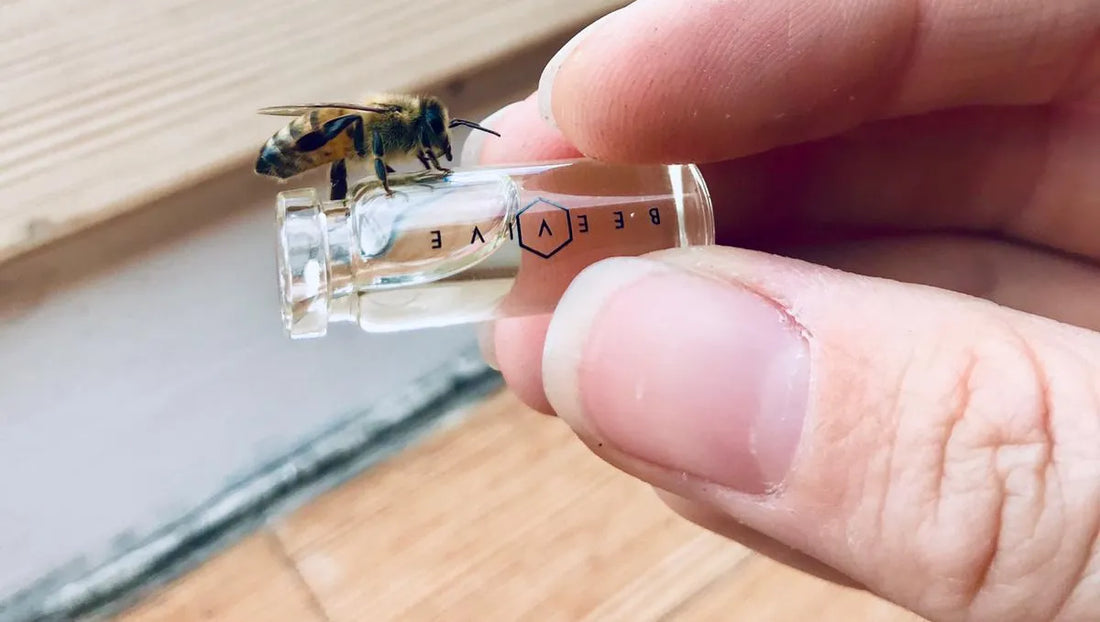When you see a bee crawling on the ground it can be hard to tell if it's injured, wet, cold or tired. If a bee isn't tired and cannot fly for another reason, attempting to prolong its suffering isn't a good idea. Bees can also sleep, which means it's difficult to know if he's resting or whether he requires your help to support him in his mission to pollinate planet earth.
Before you perform a bee rescue operation, here are the 4 types of bee you will come across:
1 ) A Tired Bee
Tired bees are slow-moving, lethargic and can be found in the grass, pavement or road for some time or in bad weather conditions. If he's not visibly wet, injured or cold, there's a good chance he is an exhausted bee and could do with a little help.
How to Help
To save a tired bee, you should place him on a flower nearby. Sugar solution is not bad for bees, but it should never be used to replace nectar and pollen as these contain other nutrients and fats which are not present in the sugar water.
If he hasn't changed his behaviour after a little while, you can revive the bee. Offer him a drop or two of sugar solution from your keyring or mix 50/50 white sugar and water yourself. Making up your own bees sugar water is fine, but our keyrings use ambrosia®, which is a ready-to-use specialist sugar water for bees and used in professional bee-keeping. Unlike white sugar, ambrosia's high sugar concentration makes it resistant to spoiling from microbiological effects and can last longer to save multiple bees.
Some websites suggest waiting up to 45 mins before you give them sugar water, but the issue is that you don't know how long the bee has been there. Wait only after you have offered him some sugar water. Bees could drink from a teaspoon, the ground or sometimes the bottle. If he drinks from the bottle you must replace the solution and never pour it directly on the bee as drowning him won't help!
 Photo by Nigel Jones (Devonshire Magazine)
Photo by Nigel Jones (Devonshire Magazine)
 Photo by community member, Emily Briggs (UK)
Photo by community member, Emily Briggs (UK)
 Photo by community member, Vlada Haggerty (USA)
Photo by community member, Vlada Haggerty (USA)
 Photo by bee-saving duo Hayley & Richard
Photo by bee-saving duo Hayley & Richard
 Rescued paddleboarding by Renea Scarrett
Rescued paddleboarding by Renea Scarrett
2 ) *Phew* I Need a Rest. Let me Bee!
Don't confuse tired bees with resting ones. Queen bees are notorious for being mistaken as tired/struggling bees as they spend most of their time grounded after only short flights.
Sometimes, a bumblebee queen secludes herself as she is fat and mated, or ready for hibernating. Don't move her unless she is in harm's way or obvious to predators. Placing her on a nectar-rich flower or under the cover of leaves works best as the Bee Conservation instructs.
Male bees can also be found resting late at night or early in the morning on flowers and covered in dew. You can spot these when their heads are down, have still antennae or have fallen sideways. Don't worry, they will wake up when they are warmed by the sunshine. If the bee is drenched and it's not at these peak sleeping times, a sunny spot or a few hours in your house is all that's needed.
3 ) All-Aboard the Bumblebee Bus!
You may also see some mites on the bees back. Bees are pretty sturdy beings and are built to carry heavy pollen. A few passengers won't hinder him and if he's not in a dangerous place, it's best to leave him alone as these 'hitchhiking' mites just feed on bee nest debris.
In the rare case that he looks heavy-laden with mites, you can brush some off with a delicate paintbrush. You can see what bumblebee mites look like on the video below, thanks to our community member Daisy Tate.
4 ) The Bees That Buzz No More
Sometimes you will find a dead or a sick bee. Bees surprisingly only have an active life as an adult for 4-6 weeks.
But, why do bumblebees die?
It's down to old age, diseases or an injury.
Ageing bees have noticeably darker, black bodies as they have lost their hair and have ragged wings. Some lethargic and slow-moving bees contain parasites, diseases or injuries that we cannot see.
Pesticides are another killer. The easiest way to tell if a bee has been poisoned is when its tongue is hanging out. It's not a nice image, but if your attempts at bee revival aren't working, know that there is nothing you can do at this point. Sadly, bees die all the time. A honey bee colony can lose thousands of its workers each day.
Summing Up
Overall, analysing a bee's symptoms and the environment you found him in is essential to saving bees. As we go into spring, you will see them frequently so lookout for anyone who needs an energy drink!
A stable bee's diet, however, is made up of all the essential nutrients, protein and carbohydrates in pollen and nectar. Growing bee-friendly plants is one of the best ways of helping bees in the garden and prevent any tired bees in the first place.
Remember that they are not pets and if you do help a bee out, keep your interactions short to let nature take its course too.
We hope this helps you spot a tired bee and remember to bee proud of your spontaneous encounter today!
Check out our more detailed step-by-step guide for how to save a bee and find out why saving them is important.


